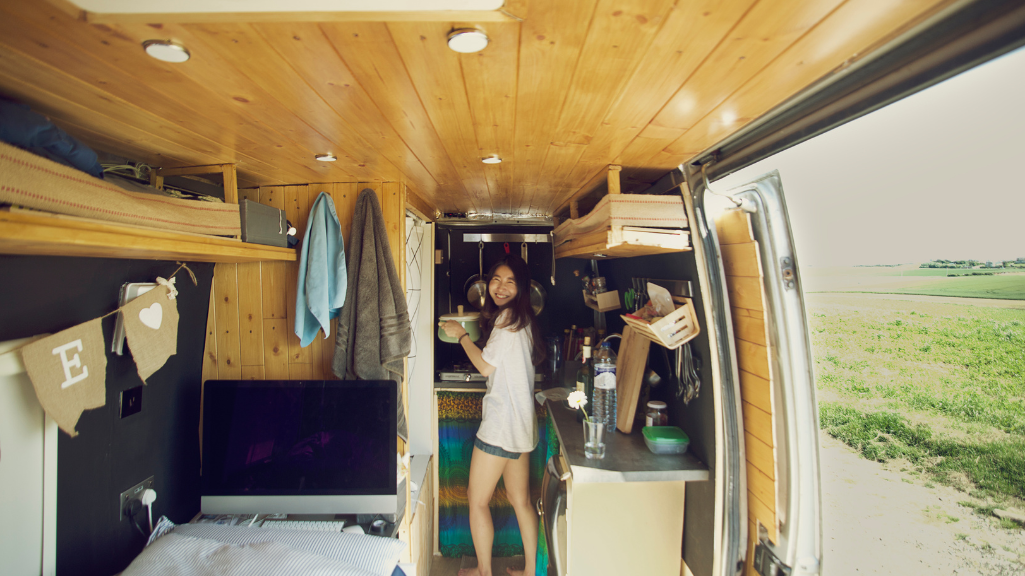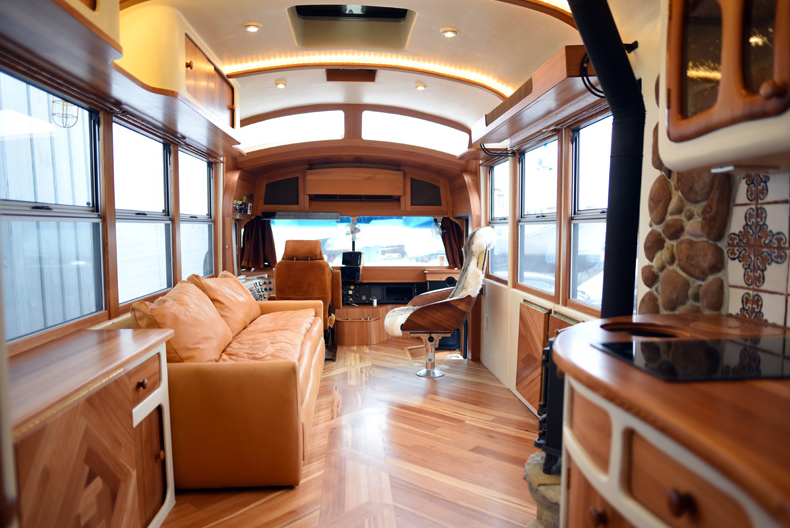Unleash Your Inner Nomad: 10 Thrilling Ways to Embrace Life on the Road
SEO Meta-description
Discover the top 10 ways to live like a modern nomad, from custom vans and upscale RVs to sailboats and minimalism. Embrace the freedom and adventure of life on the road with these inspiring stories and practical tips.
Introduction
In recent years, the nomadic lifestyle has captivated the hearts and minds of adventurers worldwide. While the dictionary defines a nomad as “a member of a people having no permanent abode, and who travel from place to place to find fresh pasture for their livestock,” modern nomads have put their own spin on this age-old way of life. Driven by a desire to escape the stressors of contemporary society or forced into this lifestyle by circumstance, an increasing number of individuals and families are embracing life on the road.
The nomadic lifestyle has become so popular that it even inspired the critically acclaimed book “Nomadland: Surviving America in the Twenty-First Century” by Jessica Bruder, which was later adapted into an Oscar-winning film directed by Chloé Zhao. This book offers a poignant glimpse into the lives of modern nomads as they navigate the challenges and joys of life in post-9/11 America.
In this article, we’ll explore the top 10 best ways to live like a nomad, drawing inspiration from the incredible stories of those who have boldly embarked on this unconventional path. From custom vans and upscale RVs to sailboats and minimalist living, get ready to unleash your inner nomad and discover the freedom and adventure that awaits you on the open road. Copy
Key Takeaways
- Living like a nomad offers a unique opportunity for adventure, personal growth, and freedom from societal norms and expectations.
- There are many ways to embrace the nomadic lifestyle, from converting a van or car to living in an RV, sailboat, or luxury motorhome.
- Succeeding as a nomad requires careful planning, financial preparation, and a willingness to embrace minimalism and adaptability.
- Building a strong support network, both within the nomadic community and with friends and family, is essential for staying connected and motivated.
- Embracing the nomadic lifestyle can lead to incredible experiences, personal growth, and a deeper appreciation for the world around you.
10. Solo in a Custom Van

For many young adults, the astronomical cost of living has fueled a growing interest in alternative lifestyles. Among these is Amanda, who, along with her faithful canine companion Frank, has embraced the freedom and simplicity of life in a custom van. Amanda’s journey began when she found herself trapped in the cycle of working tirelessly to afford a home while sacrificing the things she truly enjoyed. Determined to break free, she initially moved into a tent, which eventually led her to the van life.
Amanda’s custom van is a testament to her creativity and resourcefulness. Inside, you’ll find cherished family heirlooms, artwork crafted by talented friends, and clever storage solutions that maximize every inch of space. For Amanda and Frank, van life represents the essence of simplicity, freedom, and a life rich in experiences rather than material possessions.
Embarking on the solo van life journey offers numerous benefits, such as:
- Cost-effectiveness: Living in a van significantly reduces expenses like rent, utilities, and home maintenance.
- Freedom to explore: With your home on wheels, you have the liberty to travel wherever your heart desires, immersing yourself in new environments and experiences.
- Minimalism: Van life encourages you to prioritize experiences and relationships over material possessions, leading to a simpler, more fulfilling existence.
If you’re considering the solo van life, here are some tips to help you get started:
- Research and plan extensively before making the leap, ensuring that this lifestyle aligns with your goals and values.
- Choose a van that suits your needs and budget, considering factors such as size, reliability, and fuel efficiency.
- Customize your van to create a comfortable and functional living space, incorporating elements that reflect your personality and priorities.
- Develop a reliable income stream that allows you to sustain your nomadic lifestyle, whether through remote work, freelancing, or passive income.
- Cultivate a support network of fellow nomads and loved ones who understand and encourage your unconventional path.
By embracing the solo van life, you open yourself up to a world of adventure, personal growth, and the opportunity to create a life that truly resonates with your soul. Copy
9. Live Like Bob Wells
Bob Wells, affectionately known as “Vandweller,” is an American YouTuber, author, and pioneer in the nomadic community. Although his initial foray into van life was born out of necessity, Bob soon discovered that this unconventional lifestyle suited him perfectly. With over 20 years of experience living in mobile homes and cars, Bob has become an invaluable resource for aspiring nomads, sharing his wisdom through his YouTube channel, CheapRVliving.
One of Bob’s most significant contributions to the nomadic community is the Rubber Tramp Rendezvous (RTR), an annual gathering that brings together thousands of individuals living in their vehicles. The RTR provides a platform for nomads to connect, share knowledge, and foster a sense of belonging in a community that often defies societal norms.
Inspired by his own journey, Bob founded the “Homes on Wheels Alliance,” a charity that provides livable cars and vans to those in need. Through this initiative, Bob has helped countless individuals escape homelessness and embark on a path towards self-sufficiency and personal growth.
For those eager to follow in Bob’s footsteps, his YouTube channel offers a wealth of information, including:
- Tips for living comfortably in your vehicle
- Tutorials on installing solar panels and creating a self-sufficient power system
- Advice on finding affordable dental and vision care while on the road
- Insights on building meaningful connections within the nomadic community
Living like Bob Wells requires a shift in mindset, embracing a life that prioritizes experiences, personal growth, and the power of community over material possessions and societal expectations. By doing so, you open yourself up to a world of possibilities and the chance to create a life that is truly your own. Copy
8. Become an Upscale RVer
Self-converted Off-Grid Sprinter Van
Watch this video on YouTube
For those with a substantial budget or a house to sell, the life of an upscale RVer might be the perfect way to embrace the nomadic lifestyle without sacrificing comfort or amenities. While a brand-new, high-end RV can cost upwards of $300,000, a used RV can be purchased for a more reasonable $15,000 to $40,000.
The allure of the upscale RV life is evident in the growing number of Americans embracing this lifestyle. According to a Washington Post article, an estimated one million Americans live full-time in RVs, with many claiming that this decision has strengthened their marriages and brought their families closer together.
Some of the benefits of living in an upscale RV include:
- Space: Compared to vans or cars, RVs offer significantly more living space, making them ideal for families or those who value a more spacious environment.
- Amenities: Many upscale RVs come equipped with full kitchens, bathrooms, and ample storage, providing the comforts of a traditional home on wheels.
- Comfort: With features like air conditioning, heating, and plush furnishings, upscale RVs offer a level of comfort that can make life on the road feel luxurious.
- Family-friendly: The spacious layout of most RVs makes them well-suited for families, with some models comfortably accommodating up to six people.
If you’re considering becoming an upscale RVer, keep in mind the following factors:
- Maintenance and repair costs: Owning an RV comes with additional expenses, such as regular maintenance, repairs, and insurance.
- Fuel costs: Larger RVs often have lower fuel efficiency, which can impact your travel budget.
- Parking and campground fees: Upscale RVs may require larger parking spaces and hookups, which can increase the cost of staying at campgrounds or RV parks.
- Towing capacity: If you plan on towing a car or trailer behind your RV, ensure that your vehicle has the necessary towing capacity.
By embracing the life of an upscale RVer, you can enjoy the freedom and adventure of the nomadic lifestyle while maintaining many of the comforts and conveniences of a traditional home. Copy
7. The Converted Sprinter Van
For those seeking a balance between the compact nature of a van and the comfort of an RV, a converted sprinter van might be the perfect solution. Chris and Sara, a husband-and-wife duo, have transformed their sprinter van into a stunning mobile home complete with a tiled shower, advanced security system, fully-equipped kitchen, and dedicated office space.
“Hey y’all! We’re Chris + Sara, a husband-and-wife travel duo currently working and traveling full time with our pup, Kramer. We’ve always dreamed of traveling full time, and in May of 2018, we took the leap and made it happen! Today we’re balancing work and fun everywhere between the Pacific and Atlantic. From hiking and cycling to tacos and coffee, we’re trying to see and experience as much of this world as we can! While our home is currently on wheels in our DIY Sprinter van, our travels take us all around the world.”
Converting a sprinter van into a livable space offers several advantages:
- Versatility: Sprinter vans are large enough to accommodate a range of amenities while still being compact and easy to maneuver.
- Stealth camping: The unassuming appearance of a sprinter van allows for more discreet urban camping compared to larger RVs.
- Customization: With a blank canvas to work with, you can design and customize your van to perfectly suit your needs and preferences.
However, it’s essential to consider the costs associated with a sprinter van conversion:
- Base vehicle cost: Sprinter vans typically start around $50,000, which is a significant upfront investment.
- Conversion costs: Depending on the level of customization and whether you choose to DIY or hire professionals, converting your van can add tens of thousands of dollars to the total cost.
- Time investment: If you opt for a DIY conversion, be prepared to invest a substantial amount of time and effort into the project.
Despite the costs, many nomads find that the freedom and flexibility offered by a converted sprinter van make it a worthwhile investment. By carefully planning your build and prioritizing the features that matter most to you, you can create a mobile home that perfectly suits your nomadic lifestyle. Copy
6. The Minimalist Nomad
For many modern nomads, the desire to embrace a life on the road stems from a yearning to break free from the constraints and expectations of contemporary society. Minimalism, a philosophy that emphasizes living with less and focusing on experiences rather than possessions, has become a central tenet of the nomadic lifestyle.
Minimalist nomads recognize that the burden of material possessions can hinder their ability to fully embrace the freedom and spontaneity of life on the road. By downsizing not only their living space but also their belongings, they create a lifestyle that allows them to pick up and go at a moment’s notice, unfettered by the weight of excess.
If you’re drawn to the idea of becoming a minimalist nomad, consider the following:
- Evaluate your possessions: Take a critical look at your belongings and identify the items that truly add value to your life. Eliminate anything that doesn’t serve a purpose or bring you joy.
- Prioritize experiences: Shift your focus from acquiring things to seeking out new experiences and adventures. Invest in memories rather than material goods.
- Embrace versatility: Choose multi-functional items that serve multiple purposes, such as clothing that can be dressed up or down or kitchen tools that can be used for various tasks.
- Digitize your life: Reduce physical clutter by digitizing documents, photos, and other media. Cloud storage and digital organization tools can help you maintain a minimalist lifestyle while still preserving important information.
- Cultivate contentment: Practice gratitude for the things you have and the experiences you’ve had. Recognize that true happiness comes from within, not from external possessions.
Embracing minimalism as a nomad requires a shift in mindset and a willingness to let go of societal norms and expectations. By focusing on what truly matters and learning to find joy in the simple things, you can create a life of freedom, flexibility, and profound contentment on the road. Copy
5. The Digital Nomad
How to Become a Digital Nomad
Watch this video on YouTube
In recent years, the concept of the digital nomad has taken the world by storm. A digital nomad is an individual who leverages technology to work remotely, allowing them to travel and live a nomadic lifestyle while still maintaining a career. This way of life has become increasingly popular, particularly in the wake of the COVID-19 pandemic, which has led to a surge in remote work opportunities.
Digital nomads come from a wide range of professions, including:
- Freelance writers, designers, and developers
- Online entrepreneurs and e-commerce business owners
- Remote employees of companies that embrace flexible work arrangements
- Consultants and coaches who offer their services virtually
The appeal of the digital nomad lifestyle lies in its flexibility and the opportunity to combine work and travel seamlessly. By leveraging tools like video conferencing, project management software, and cloud storage, digital nomads can effectively collaborate with clients and colleagues from anywhere in the world.
To succeed as a digital nomad, consider the following tips:
- Develop a strong online presence: Establish a professional website and social media profiles that showcase your skills and expertise. This will help you attract clients and build credibility within your niche.
- Invest in reliable technology: Ensure that you have a high-quality laptop, smartphone, and any other tools necessary for your work. Reliable internet access is also crucial, so consider purchasing a mobile hotspot or investing in a global Wi-Fi plan.
- Create a routine: While the freedom of the digital nomad lifestyle is appealing, it’s essential to establish a routine that balances work and play. Set aside dedicated work hours and create a schedule that allows you to explore your surroundings while still meeting your professional obligations.
- Embrace a minimalist mindset: As a digital nomad, you’ll likely be living out of a suitcase or backpack. Embrace minimalism and focus on essential items that support your work and lifestyle.
- Build a support network: Connect with other digital nomads through online communities, co-working spaces, and local meetups. Having a support network can help you navigate the challenges of the nomadic lifestyle and provide valuable opportunities for collaboration and friendship.
The digital nomad lifestyle offers an exciting opportunity to blend work and travel, allowing you to experience new cultures, expand your horizons, and grow both personally and professionally. With the right mindset, tools, and support system, you can thrive as a digital nomad and create a life of adventure and purpose. Copy
4. Converting Your Car into a Tiny House
For those seeking an even more affordable and minimalist approach to nomadic living, converting a car into a tiny house on wheels might be the perfect solution. In her popular YouTube video, Alyssa Vanilla shares her experience transforming her hatchback into a cozy and functional living space.
Converting a car into a tiny house offers several advantages over larger vehicles like vans or RVs:
- Affordability: Cars are generally much cheaper to purchase and maintain than larger vehicles, making them an attractive option for budget-conscious nomads.
- Fuel efficiency: Smaller cars typically have better fuel economy, which can help keep travel costs down over time.
- Ease of parking: Compact cars can fit into smaller parking spaces and are easier to maneuver in urban environments, making it simpler to find overnight parking and explore new cities.
However, converting a car into a livable space also comes with its own set of challenges:
- Limited space: Cars offer significantly less living space than vans or RVs, which can require creative solutions for storage and organization.
- Stealth camping: While cars are more discreet than larger vehicles, it’s still essential to be mindful of local laws and regulations regarding overnight parking and camping.
- Comfort and amenities: Due to the limited space, converting a car into a tiny house may require sacrificing certain comforts and amenities, such as a built-in bathroom or kitchen.
If you’re considering converting your car into a tiny house, here are some tips to keep in mind:
- Choose the right vehicle: Look for a car with a spacious interior and reliable mechanical components. Hatchbacks, wagons, and SUVs are popular choices for car conversions.
- Prioritize insulation and ventilation: Proper insulation and ventilation are crucial for maintaining a comfortable living environment in a small space. Consider using reflective insulation and installing a roof vent or window coverings to regulate temperature and airflow.
- Maximize storage: Utilize every available inch of space for storage, including under-seat compartments, roof racks, and hanging organizers. Multi-functional furniture, such as a storage bench that doubles as a bed, can also help make the most of your limited space.
- Invest in a good mattress: A comfortable sleeping surface is essential for your well-being and can make a significant difference in your overall experience living in a car.
- Embrace minimalism: Living in a car requires a significant downsizing of possessions. Embrace the minimalist mindset and focus on essential items that serve multiple purposes.
By converting your car into a tiny house, you can experience the freedom and adventure of the nomadic lifestyle while keeping costs low and maintaining a small environmental footprint. With creativity, resourcefulness, and a willingness to embrace simplicity, you can transform your car into a cozy and functional home on wheels. Copy
3. The Renovated School Bus

For those who crave more space and the opportunity to create a truly unique living environment, a renovated school bus might be the perfect nomadic home. Affectionately known as “skoolies,” these converted buses offer a blank canvas for creating a comfortable and personalized living space on wheels.
One couple, featured in the video above, transformed a school bus into a stunning tiny home complete with a shower, composting toilet, closet, living room, bedroom, and kitchen. By doing the majority of the work themselves, they were able to complete the project for around $15,000, resulting in a spacious and functional home that allows them to travel the country with their two dogs.
Some of the benefits of living in a renovated school bus include:
- Space: School buses offer significantly more living space than vans or cars, allowing for more amenities and a more comfortable living environment.
- Customization: With a large, empty interior, school buses provide ample opportunity for personalization and customization, allowing you to create a living space that truly reflects your style and needs.
- Community: The skoolie community is known for its creativity, resourcefulness, and willingness to share knowledge and skills, providing a supportive network for those embarking on a bus renovation project.
However, renovating a school bus also comes with its own set of challenges:
- Mechanical knowledge: School buses are large, complex vehicles that require specialized knowledge for maintenance and repairs. It’s essential to have a thorough understanding of the bus’s mechanical systems or to have access to reliable resources and support.
- Zoning laws: Some cities and towns have specific zoning laws that prohibit living in vehicles, including renovated school buses. It’s crucial to research local regulations and to have a plan for where to park and reside in your bus.
- Initial investment: While a renovated school bus can be a more affordable option than purchasing a new RV, the upfront costs of buying and renovating a bus can still be substantial.
If you’re considering creating a home in a renovated school bus, keep these tips in mind:
- Choose the right bus: Look for a bus with a solid mechanical foundation and minimal rust. Consider factors such as engine type, transmission, and the overall condition of the bus before making a purchase.
- Plan your layout: Before beginning the renovation process, create a detailed floor plan that takes into account your specific needs and lifestyle. Consider factors such as sleeping arrangements, kitchen and bathroom placement, and storage solutions.
- Prioritize safety: Ensure that your renovation adheres to proper safety standards, including adequate insulation, ventilation, and fire safety measures.
- Embrace the journey: Renovating a school bus is a significant undertaking that requires patience, perseverance, and a willingness to learn new skills. Embrace the process as part of the adventure and celebrate the milestones along the way.
Living in a renovated school bus offers a unique and rewarding way to experience the nomadic lifestyle, with the potential for a spacious, personalized, and comfortable home on wheels. By embracing the challenges and opportunities of the renovation process, you can create a one-of-a-kind living space that reflects your individual style and supports your adventures on the road. Copy
2. The Self-Sufficient Sailor


Watch this video on YouTube
For those who feel the call of the sea, living aboard a sailboat can offer a unique and adventurous way to embrace the nomadic lifestyle. Brian and Karin Trautman, a couple who have been living on a sailboat for over a decade, have created a self-sufficient floating home that allows them to explore the world’s oceans while living sustainably.
“Brian and Karin Trautman have been living on a sailboat for 10 years, and their boat is set up so they can be off the grid in remote places for months at a time with solar and wind power providing electricity, a water maker that turns salt water into fresh water, multiple freezers and loads of storage space for food, and even a small washing machine on board!
They’ve sailed 83,000 nautical miles, which is the equivalent of circling the earth at the equator more than three times. Their latest adventures include sailing as a family with their 6-month baby, Sierra, and outfitting the boat with a heater so they can explore the Arctic this summer after several years in the Tropics.”
Living as a self-sufficient sailor offers several unique advantages:
- Sustainable living: With the ability to generate your own power, produce fresh water, and store provisions, living on a sailboat allows for a more sustainable and environmentally conscious way of life.
- Endless exploration: With the world’s oceans as your backyard, living on a sailboat offers endless opportunities for exploration and adventure, from tropical paradises to remote arctic landscapes.
- Simplified living: Life on a sailboat requires a minimalist approach to possessions and a focus on essential skills and self-sufficiency, promoting a simpler and more intentional way of life.
However, the sailing life also comes with its own set of challenges:
- Initial investment: Purchasing and outfitting a sailboat for long-term living can be a significant financial investment, often requiring the sale of a home or substantial savings.
- Specialized skills: Navigating and maintaining a sailboat requires a unique set of skills, including seamanship, navigation, and mechanical knowledge. It’s essential to invest time in learning and developing these skills before embarking on a sailing journey.
- Isolation and limited resources: Living on a sailboat can be isolating at times, with limited access to resources and amenities. It’s crucial to be prepared for self-sufficiency and to have a plan for accessing necessary supplies and support.
If you’re considering embarking on a life as a self-sufficient sailor, keep these tips in mind:
- Gain experience: Before committing to living aboard a sailboat, gain experience through sailing courses, charters, and crewing opportunities. This will help you develop essential skills and determine if the lifestyle is right for you.
- Choose the right boat: Consider factors such as size, layout, and equipment when selecting a sailboat for long-term living. Prioritize boats with proven seaworthiness and the capacity for self-sufficiency.
- Embrace community: Connect with other sailors and liveaboards through online forums, marinas, and sailing events. The sailing community is known for its camaraderie and willingness to share knowledge and resources.
- Prepare for challenges: Living on a sailboat requires resilience, adaptability, and a positive mindset. Be prepared for the challenges of weather, mechanical issues, and limited resources, and cultivate the skills and attitudes necessary to overcome them.
By embracing the life of a self-sufficient sailor, you can experience the ultimate sense of freedom and adventure, exploring the world’s oceans while living sustainably and intentionally. With the right preparation, mindset, and skills, living aboard a sailboat can offer a truly unique and rewarding way to embrace the nomadic lifestyle. Copy
1. The Truly Unaffordable Space-Ship on Wheels
For those with an unlimited budget and a taste for luxury, the ultimate nomadic home might just be a high-end motorhome that rivals the opulence of a private jet. These lavish homes on wheels offer every conceivable amenity and comfort, allowing you to travel in style and sophistication.
The video above showcases one such motorhome, a veritable “spaceship on wheels” that boasts features like:
- Automated blinds and shades for privacy and temperature control
- Ample storage space for clothing, gear, and provisions
- A luxurious bedroom with a queen-sized bed and high-end linens
- A spacious bathroom with a shower, sink, and toilet
- A gourmet kitchen with top-of-the-line appliances and ample counter space
- A built-in garage for storing outdoor gear or even a small car
Of course, this level of luxury comes at a significant cost. High-end motorhomes like the one featured can easily cost several million dollars, putting them out of reach for all but the wealthiest of nomads.
However, for those who can afford it, traveling in a motorhome of this caliber offers an unparalleled level of comfort and convenience. With every need and desire accounted for, you can focus on the joys of exploration and adventure, without sacrificing any of the luxuries of a high-end home.
If you’re considering investing in a high-end motorhome, keep these factors in mind:
- Maintenance and operating costs: In addition to the initial purchase price, high-end motorhomes come with significant ongoing costs, including maintenance, fuel, and parking fees. Be prepared for the financial commitment of owning and operating a luxury vehicle.
- Size and maneuverability: Large, luxurious motorhomes can be challenging to maneuver and park, particularly in urban or crowded areas. Consider the size and turning radius of the vehicle when planning your travels.
- Lifestyle fit: While a high-end motorhome offers unparalleled comfort, it may not be the best fit for those seeking a more rugged or off-the-beaten-path adventure. Consider your travel style and goals when deciding if a luxury motorhome is right for you.
For those with the means and the desire for ultimate comfort, a high-end motorhome can offer a truly unparalleled way to embrace the nomadic lifestyle. With every luxury and convenience at your fingertips, you can travel the world in style, indulging in the best that life has to offer while still embracing the freedom and adventure of life on the road. Copy
FAQs
Q. What is the best way to start living like a nomad?
A. The best way to start living like a nomad is to research and plan extensively, assess your financial situation, and start downsizing your possessions. Determine your preferred nomadic lifestyle (van life, RV living, sailboat, etc.) and start connecting with others in that community for advice and support.
Q. How do I make money while living as a nomad?
A. There are many ways to make money while living as a nomad, such as remote work, freelancing, online entrepreneurship, and seasonal jobs. Assess your skills and experience to determine the best path for you, and invest in reliable technology and internet access to support your work.
Q. Is it legal to live in a vehicle full-time?
A. The legality of living in a vehicle full-time varies by location. Research local laws and regulations regarding overnight parking, zoning, and vehicle dwelling. Be prepared to move locations frequently and always have a backup plan.
Q. How do I handle mail and official documents while living as a nomad?
A. Many nomads use mail forwarding services or virtual mailboxes to handle their mail and official documents. These services provide a stable mailing address and can forward your mail to your current location. Alternatively, you can use the address of a trusted friend or family member.
Q. How do I stay connected with friends and family while living a nomadic lifestyle?
A. Stay connected with friends and family through regular video calls, messaging apps, and social media. Plan visits and reunions when possible, and consider traveling with friends or family members for periods of time. Building a strong support network within the nomadic community can also provide a sense of connection and belonging.
Conclusion
Living like a nomad is not for everyone, but for those who feel the call of the open road and the desire for a life of adventure and freedom, it can be an incredibly rewarding and transformative experience. Whether you choose to live in a converted van, a sailboat, or a luxury motorhome, the key to success is embracing minimalism, adaptability, and a willingness to step outside of your comfort zone.
By downsizing your possessions, cultivating self-sufficiency, and building a strong support network, you can create a life of purpose and adventure on your own terms. The nomadic lifestyle offers the opportunity to explore new places, meet fascinating people, and discover your own resilience and resourcefulness.
Of course, living as a nomad is not without its challenges. It requires careful planning, financial preparation, and a willingness to embrace uncertainty and discomfort at times. But for those who are ready to take the leap, the rewards of the nomadic lifestyle are truly unparalleled.
So if you feel the call of the open road and the desire for a life of adventure and freedom, consider embracing one of these top 10 ways to live like a nomad. With the right preparation, mindset, and support, you can create a life of purpose, growth, and incredible experiences, all while living life on your own terms.



